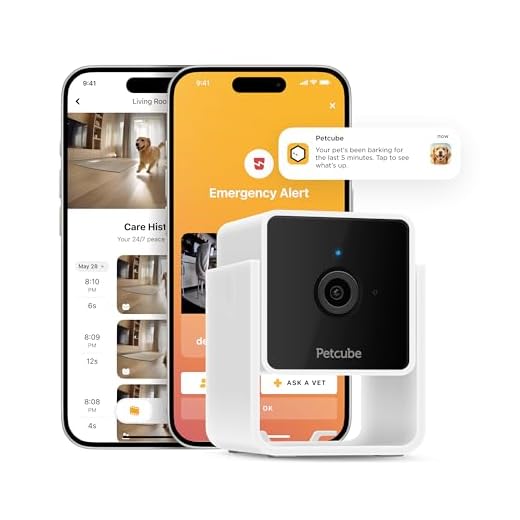




Bright, clear orbs free from any discharge indicate that everything is functioning as it should. A rich, dark pigmentation around the iris is a positive sign, suggesting good health. If you notice your furry friend’s peepers reflecting light well, it’s a reassuring indication of vitality. Regular inspection can reveal much about their overall well-being.
Pay attention to the absence of redness or swelling around the eyelids. Any irritation may signal underlying issues that require attention. A well-hydrated surface, glistening without any cloudiness, showcases proper hydration and care. If you observe consistent clarity, you can be confident that your four-legged companion is thriving.
Regular check-ups with the vet can help maintain this clarity. During these visits, it’s wise to ask about any changes in habits or behaviours that may relate to vision. An alert and responsive attitude often correlates with good ocular condition, so keep an eye out for those signs of engagement and curiosity in their surroundings.
Characteristics of Optimally Functioning Canine Vision
Bright and clear corneas reflect a pet’s well-being. No cloudiness or redness should be present. If you notice any signs of irritation, it’s time to consult a veterinarian. A healthy pet’s sclera, or the white part, should appear white without any discolouration.
Signs of Proper Eye Health
Observe for consistent moisture; dryness can indicate an issue. Tear production is crucial, so pay attention to the presence of tears. Excessive tearing could suggest allergies or infections, while insufficient tearing might indicate dry eye syndrome.
| Condition | Observation | Action |
|---|---|---|
| Redness | Inflamed sclera | Visit a vet |
| Cloudiness | Opaque cornea | Seek veterinary advice |
| Excessive tearing | Watery discharge | Check for allergies |
| Dryness | Little to no tears | Consult a specialist |
Maintaining Optimal Eye Condition
Regular cleaning around the eyes can help prevent irritations. Use a damp cloth to gently wipe away any discharge. Ensure that your furry friend is protected from harmful UV rays by limiting their exposure to direct sunlight, and consider using protective eyewear for outdoor activities. Keep up with routine veterinary check-ups to monitor eye health, as early detection of issues can lead to better outcomes.
Significant Signs of Clear Vision in Dogs
Pay attention to the way your canine companion reacts to movement. If your furry friend tracks objects smoothly with their gaze, it indicates sharp eyesight. You might notice them following a bouncing ball or a squirrel with keen interest–this is a good sign!
Another key indicator is the absence of excessive squinting or blinking. If your pet seems comfortable and relaxed, rather than frequently rubbing their face or tearing up, it often means their vision is in good shape. Clear, bright eyes without redness or discharge suggest they are free from irritation or infection.
Behavioural Cues
Watch for how your pooch navigates their environment. Confident movements, like jumping onto furniture or navigating stairs without hesitation, imply they can see well. If they suddenly become more cautious or hesitant, it may signal a vision issue.
A genuine connection can also be seen in their interaction with you. If they respond to visual cues, such as hand signals or your facial expressions, it’s another strong sign of good sight. Engaging in games that require sight, like fetch or hide and seek, can also help confirm their visual acuity.
Regular Check-ups
Ensure you schedule routine veterinary visits. Regular check-ups can help identify any potential issues early. Maintaining a proper diet, such as the best can dog food lebanon, can also support overall health, including vision.
Being attentive to these signs can help you keep your furry friend’s sight sharp.
Colour and Clarity: Understanding Normal Eye Appearance
Bright, clear eyes with a vibrant hue indicate well-being. Typical shades include brown, blue, or green, depending on the breed. Each type has its own standard, which helps in recognising any deviations that may signify health concerns.
Pay attention to the following characteristics in the ocular region:
- Clarity: The cornea should appear transparent without any cloudiness or opacity. Cloudy eyes can indicate conditions like cataracts or other health issues.
- Conjunctiva: This area, the membrane covering the inner eyelids and the white part of the eyeball, should be pink and not red or inflamed. Redness may suggest allergies or infections.
- Pupil Size: Pupils should be equal and responsive to light. Any irregularities can signal problems with the optic nerve or other serious conditions.
- Discharge: Normal eyes should be free of excessive discharge. A small amount of watery discharge is acceptable, but thick or coloured discharge needs attention.
When observing these features, also consider the overall behaviour of your companion. A pet that squints or avoids bright light may have underlying issues that require evaluation.
Regular check-ups with a veterinarian can ensure that these aspects remain optimal. Early detection of any changes can significantly improve outcomes. Remember, maintaining eye health is a key component of overall wellness in your furry friend.
Common Eye Discomfort Indicators to Watch For
Keep an eye out for excessive tearing; this can signal irritation or infection. A clear discharge is generally normal, but if it turns yellow or green, it’s time to consult a vet. Redness around the eyelids or conjunctiva may indicate inflammation or an allergic reaction. Swelling of any kind is another red flag that warrants attention.
Behavioural Changes
Watch for changes in behaviour. If your furry friend is squinting, blinking more than usual, or rubbing their face against furniture, these may be signs of discomfort. Reluctance to play or engage in activities that require visual focus can also suggest underlying issues.
Physical Symptoms
Look for any cloudiness in the lens or unusual pupil size. If one pupil is larger than the other, or if there’s a noticeable film covering the eye, this could point to serious concerns. Pay attention to any unusual odours coming from the eyes, which might indicate infection. Regular checks can prevent minor issues from escalating into more significant problems.
Routine Eye Care Practices for Maintaining Canine Vision
Regular cleaning with a damp cloth can prevent debris buildup around the ocular area. Use a soft, lint-free cloth or special pet wipes designed for sensitive areas.
Hydration and Nutrition
Ensure your companion consumes a balanced diet rich in vitamins A and E, omega fatty acids, and antioxidants. These nutrients support overall ocular health. Fresh, clean water is equally important; dehydration can lead to various health issues, including potential vision problems.
Routine Veterinary Check-ups
Schedule annual visits to the vet for comprehensive examinations. These check-ups should include ocular assessments, allowing for early detection of conditions like cataracts or glaucoma. If any abnormalities arise, prompt veterinary intervention is key to maintaining optimal vision.
Monitor your pet’s environment. Dust, smoke, and strong chemicals can irritate sensitive eyes. Keeping their space clean and using pet-friendly products can minimise exposure to irritants.
Lastly, be observant. Changes in your pet’s behaviour, such as excessive squinting or rubbing at the face, may signal discomfort. Addressing these signs quickly can lead to effective solutions and preserve their sight.







